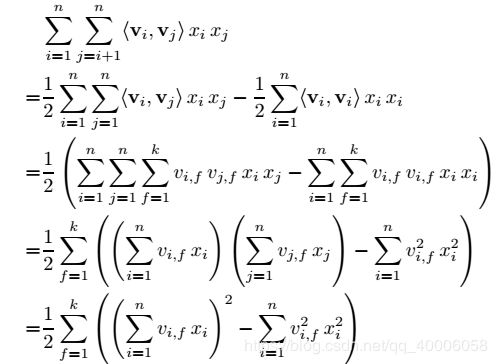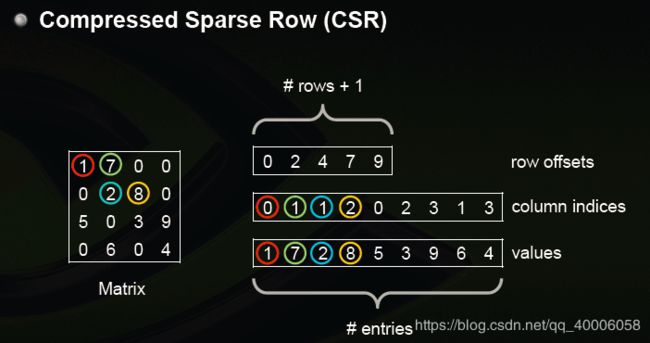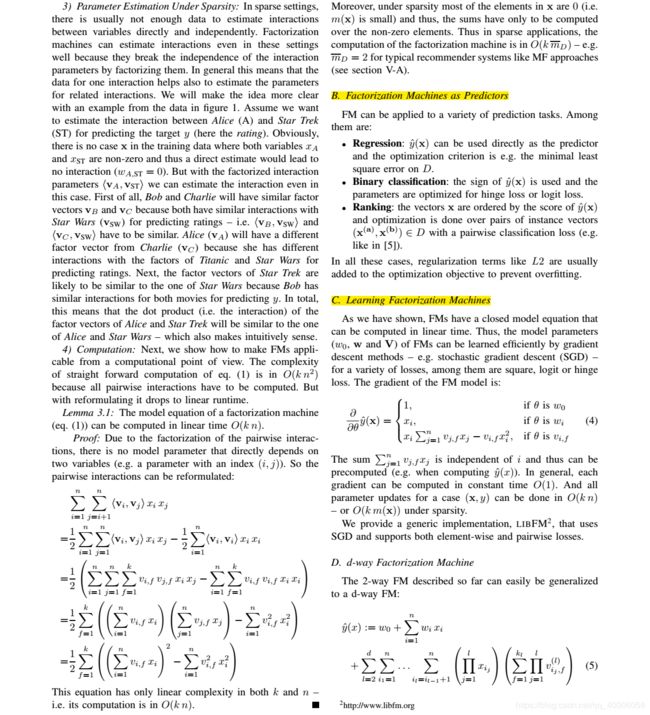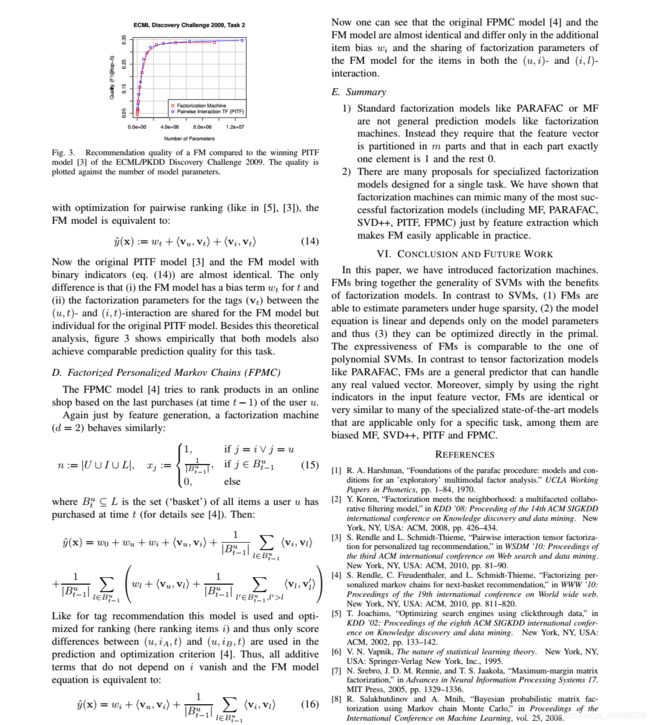《Factorization Machines》 | FM模型及python实现
1 Factorization Machines 原文
2 FM模型
2.1 背景
计算广告和推荐系统中,CTR预估是一个非常重要的环节,判断一个item是否应该被推荐要根据CTR预估的点击率进行。CTR预估时,除了单特征以外,往往需要组合特征。
数据经过one-hot编码以后,导致样本数据变得非常稀疏,另外,还导致特征空间变大。为了解决数据稀疏(one-hot coding)情况下,特征如何组合的问题,FM由此诞生。
2.2 FM模型求解
普通的现行模型,例如逻辑回归,都是单独的考虑各个特征,并没有考虑特征之间的联系。常用模型为:

从上式中可以发现,各个特征并没有进行组合,忽略了特征之间的关联。FM模型将特征进行组合,考虑了特征之间的相关关系,模型如下:

对比两个模型发现,FM比线性模型仅仅多了最后一项。

最后一项求解

利用SGD对模型参数求解

3 python实现
1、实验数据集:movielens,包含四列。【用户ID | 电影ID | 打分 | 时间戳】
2、用到的函数库
from itertools import count # 迭代器
from collections import defaultdict # 使用dict时,如果引用的Key不存在,就会抛出KeyError。如果希望key不存在时,返回一个默认值,就可以用defaultdict
from scipy.sparse import csr # csr_matrix,全名为Compressed Sparse Row,是按行对矩阵进行压缩的。CSR需要三类数据:数值,列号,以及行偏移量。CSR是一种编码的方式,其中,数值与列号的含义,与coo里是一致的。行偏移表示某一行的第一个元素在values里面的起始偏移位置。
import numpy as np
import pandas as pd
from sklearn.feature_extraction import DictVectorizer
import tensorflow as tf
from tqdm import tqdm_notebook as tqdm # 可以显示循环的进度条的库
3、将数据转换成一个大小为 用户ID数X电影ID数(样本数*特征总数) 的矩阵,使用scipy.sparse中的csr_matrix函数。csr_matrix((data, indices, indptr)第一个参数是数值对应下图中的data,第二个参数是每个数对应的列号column indices,第三个参数是每行的起始的偏移量row offsets。

def vectorize_dic(dic, ix=None, p=None):
"""
Creates a scipy csr matrix from a list of lists (each inner list is a set of values corresponding to a feature)
parameters:
-----------
dic -- dictionary of feature lists. Keys are the name of features
ix -- index generator (default None)
p -- dimension of featrure space (number of columns in the sparse matrix) (default None)
"""
if (ix == None):
d = count(0)
ix = defaultdict(lambda: next(d))
n = len(list(dic.values())[0]) # num samples
g = len(list(dic.keys())) # num groups
nz = n * g # number of non-zeros
col_ix = np.empty(nz, dtype=int)
i = 0
for k, lis in dic.items():
# append index el with k in order to prevet mapping different columns with same id to same index
col_ix[i::g] = [ix[str(el) + str(k)] for el in lis]
i += 1
row_ix = np.repeat(np.arange(0, n), g)
data = np.ones(nz)
if (p == None):
p = len(ix)
ixx = np.where(col_ix < p)
return csr.csr_matrix((data[ixx],(row_ix[ixx], col_ix[ixx])), shape=(n, p)), ix
cols = ['user','item','rating','timestamp']
train = pd.read_csv('data/ua.base',delimiter='\t',names = cols)
test = pd.read_csv('data/ua.test',delimiter='\t',names = cols)
x_train,ix = vectorize_dic({'users':train['user'].values, 'items':train['item'].values},n=len(train.index),g=2)
x_test,ix = vectorize_dic({'users':test['user'].values, 'items':test['item'].values},ix,x_train.shape[1],n=len(test.index),g=2)
print(x_train)
y_train = train['rating'].values
y_test = test['rating'].values
x_train = x_train.todense() # toarray returns an ndarray; todense returns a matrix. If you want a matrix, use todense otherwise, use toarray
x_test = x_test.todense()
4、生成器,
def batcher(X_, y_=None, batch_size=-1):
n_samples = X_.shape[0]
if batch_size == -1:
batch_size = n_samples
if batch_size < 1:
raise ValueError('Parameter batch_size={} is unsupported'.format(batch_size))
for i in range(0, n_samples, batch_size):
upper_bound = min(i + batch_size, n_samples)
ret_x = X_[i:upper_bound]
ret_y = None
if y_ is not None:
ret_y = y_[i:i + batch_size]
yield (ret_x, ret_y)
5、估计值计算
n,p = x_train.shape
k = 10
x = tf.placeholder('float',[None,p])
y = tf.placeholder('float',[None,1])
w0 = tf.Variable(tf.zeros([1]))
w = tf.Variable(tf.zeros([p]))
v = tf.Variable(tf.random_normal([k,p],mean=0,stddev=0.01))
#y_hat = tf.Variable(tf.zeros([n,1]))
linear_terms = tf.add(w0,tf.reduce_sum(tf.multiply(w,x),1,keep_dims=True)) # n * 1
pair_interactions = 0.5 * tf.reduce_sum(
tf.subtract(
tf.pow(
tf.matmul(x,tf.transpose(v)),2),
tf.matmul(tf.pow(x,2),tf.transpose(tf.pow(v,2)))
),axis = 1 , keep_dims=True)
y_hat = tf.add(linear_terms,pair_interactions)
6、损失函数计算:损失函数除了平方损失外,还加了l2正则项,并使用梯度下降法进行参数的更新:
lambda_w = tf.constant(0.001,name='lambda_w')
lambda_v = tf.constant(0.001,name='lambda_v')
l2_norm = tf.reduce_sum(
tf.add(
tf.multiply(lambda_w,tf.pow(w,2)),
tf.multiply(lambda_v,tf.pow(v,2))
)
)
error = tf.reduce_mean(tf.square(y-y_hat))
loss = tf.add(error,l2_norm)
train_op = tf.train.GradientDescentOptimizer(learning_rate=0.01).minimize(loss)
7、模型训练
epochs = 10
batch_size = 1000
# Launch the graph
init = tf.global_variables_initializer()
with tf.Session() as sess:
sess.run(init)
for epoch in tqdm(range(epochs), unit='epoch'):
perm = np.random.permutation(x_train.shape[0]) # 函数shuffle与permutation都是对原来的数组进行重新洗牌(即随机打乱原来的元素顺序);区别在于shuffle直接在原来的数组上进行操作,改变原来数组的顺序,无返回值。而permutation不直接在原来的数组上进行操作,而是返回一个新的打乱顺序的数组,并不改变原来的数组。
# iterate over batches
for bX, bY in batcher(x_train[perm], y_train[perm], batch_size):
_,t = sess.run([train_op,loss], feed_dict={x: bX.reshape(-1, p), y: bY.reshape(-1, 1)})
print(t)
errors = []
for bX, bY in batcher(x_test, y_test):
errors.append(sess.run(error, feed_dict={x: bX.reshape(-1, p), y: bY.reshape(-1, 1)}))
print(errors)
RMSE = np.sqrt(np.array(errors).mean())
print (RMSE)


